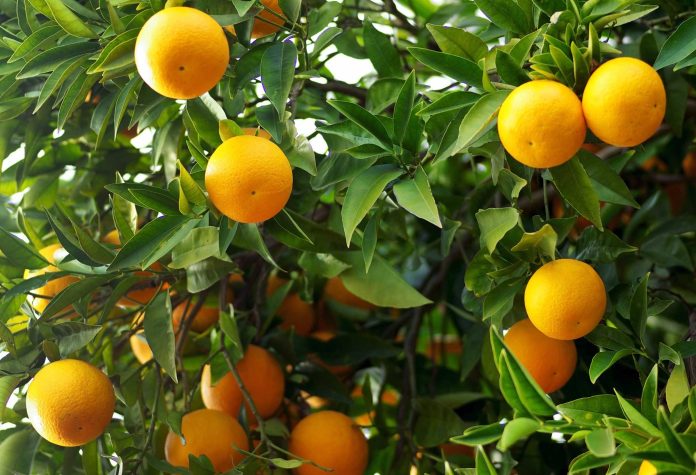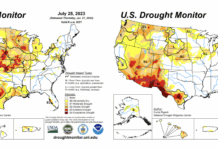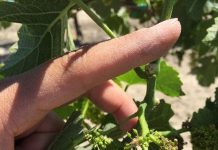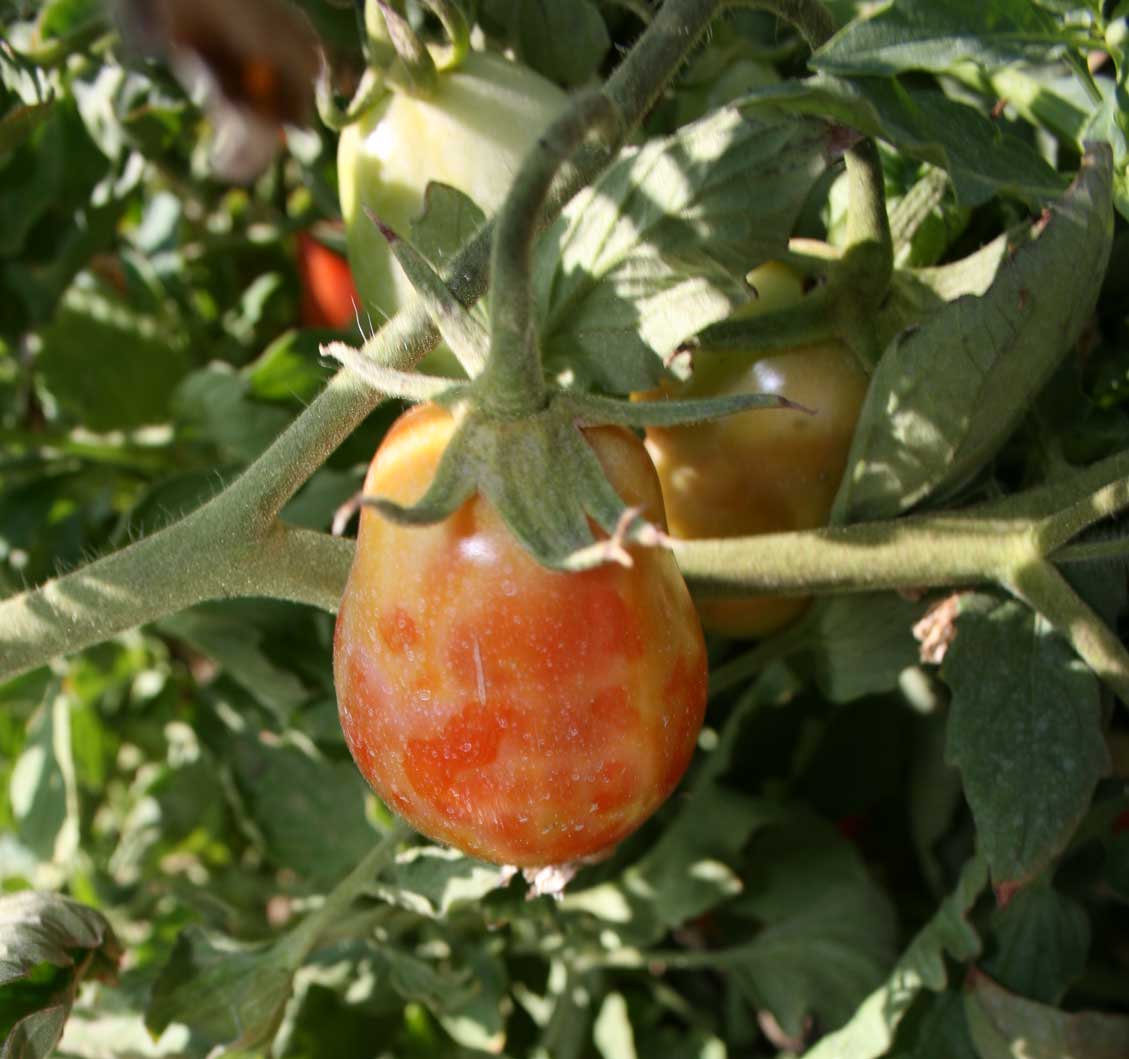(originally March/April 2017)
Citrus thrips is a common pest of California citrus, attacking leaves and the calyx end of newly forming fruit, when the epidermal cells are quite sensitive. In leaves, this causes distortion of the leaves and light lines of scarring
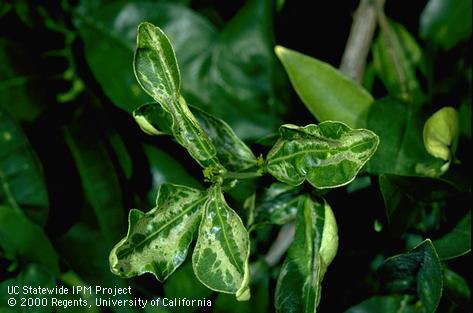
(Photo 1).
When they infest fruit, their feeding under the calyx at the stem end leaves a ring-shaped silvery scar that is retained when the fruit is mature
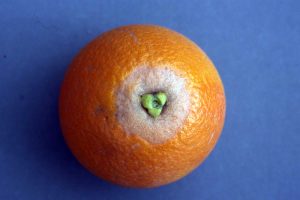
(Photo 2).
Biology of Citrus Thrips
Citrus thrips deposit their eggs in leaves, stems and fruit of citrus trees and the hatching 1st and 2nd instar larvae
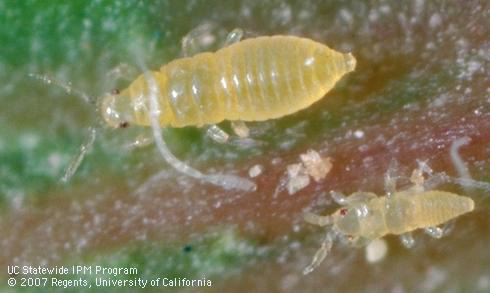
(Photo 3) live on leaves and under the sepals of fruit. Some thrips pupate in the cracks and crevices of the tree and about 2/3 drop to the soil to pupate. The adults emerge, mate and begin laying eggs and the cycle continues. The first generation of citrus thrips attacks the new leaf flush and the 2nd and 3rd generations attack the new fruit. They damage the leaves and fruit when they repeatedly stick their needle-like mandible into the epidermal cells and then suck up the fluids that are released. Citrus thrips are thigmotactic, that is they like to be in tight places such as under the calyx of the fruit. The continuous piercing of cells is what leaves a scar and as the fruit grows so the ring scar grows. The 2nd instar larvae are more damaging than the first instar larvae and the adults cause little damage to fruit. Fruit that is heavily damaged will be downgraded from fancy to choice or even to juice grade, reducing returns for the grower. Fruit is susceptible to this type of damage from petal fall until it reaches about 1.5 inches in diameter and the cells become difficult for the thrips to pierce. The fruit sensitive period ranges from 6-10 weeks after petal fall. The next 4-5 generations of thrips feed on leaf flush and the last generation lays the eggs that overwinter.
Natural enemies of thrips
There are a number of natural enemies that can attack thrips, but because the eggs are embedded in leaves, the pupae in underground and the larvae hiding in cracks and crevices, generalist predators generally don’t reduce thrips populations quickly enough or low enough to prevent scarring damage. One of the best biological control agents is the predatory mite Euseius tularensis, which is naturally found on citrus trees and feeds on the 1st and 2nd instar larvae. However, because the predatory mite feeds on lots of other type of food (pollen, leaf sap, red mites) it does not always control citrus thrips at the level that growers need, and so often insecticides are necessary. If growers use insecticides that allow the predatory mites to survive, they can assist with citrus thrips control.
Managing citrus thrips in young citrus trees
While it is tempting to treat flush for citrus thrips to reduce leaf damage, studies of young navels and Valencia oranges conducted by Drs. Morse and Grafton-Cardwell in the 1980-90s demonstrated that continuously treating 1-3 year old trees did not improve the growth or yield of the trees. Citrus trees can tolerate extreme amounts of leaf damage and continue to grow and produce well. However, there are conditions where protection is helpful. For example, the combined impact of citrus thrips and citrus leafminer (arrived in California in 2000) on young trees needs to be studied. Secondly, we have had five years of severe drought and these hot, dry conditions promote citrus thrips populations which can then have an impact on trees that normally withstand their damage.
Managing citrus thrips in mature citrus orchards
If a grove is more than 3 years old, leaf damage caused by citrus thrips should be ignored and the focus of management should be on the new fruit during the period from petal fall till the fruit is 1.5 inches in diameter. Minimizing sprays is important for several reasons: 1) to reduce the impact on natural enemies needed for citrus thrips or other pests and 2) so that resistance to pesticides doesn’t develop in the thrips. The more generations of citrus thrips you treat, the faster resistance will develop. Starting at petal fall, Pest Control Advisors (PCAs) sample 100 fruit per site and determine the % of fruit with immature citrus thrips. At petal fall this can be a bit tricky because western flower thrips will be present and this species does not damage citrus fruit. The body shape and activity of these two species of thrips is very different – citrus thrips are quick moving, short and stout while western flower thrips move slowly in a serpentine fashion and have longer cigar-shaped bodies. It is important to wait till there are immature citrus thrips on the fruit, because in some years, petal fall does not coincide with the appearance of immature citrus thrips. During the organophosphate era, the recommendation for navels was treat when there were 5% of fruit infested with immature thrips and if predatory mites were in sufficient numbers to assist (> 0.5 predatory mites/leaf) wait until there were 10% of the fruit infested. In the current era, of more selective and slower acting insecticides, the threshold for tolerance may be lower, but it is still important to wait till the thrips immatures are present on young citrus fruit before treating. No research has been done on the impact of citrus thrips on mandarin production and some varieties may be highly susceptible and need protection, while others may need no protection. Finally, citrus thrips are much harder to control in drought years than cool wet years. Wet weather helps to reduce the pupae in the soil, while hot weather accelerates thrips development and allows the pupae to survive in the soil.
Pesticide resistance
Citrus thrips are very prone to developing resistance. The developed resistance to DDT in the 1940s, the organophosphates and carbamates in the 1980s, and the pyrethroids in the 1990s. Some of these insecticides seemed to make the thrips ‘mad’, as continued use actually made thrips populations reproduce more. Since about 1998, grower have used primarily the group 5 insecticides Success/Entrust (spinosad) and Delegate (spinetoram). Heavy reliance on this one mode of action is likely to eventually lead to resistance. Thus growers are encouraged to minimize insecticide use and rotate with other thrips effective insecticides such as group 28 Exirel (cyantraniliprole), group 6 Agri-Mek/generics (abamectin) and the botanical Veratran (sabadilla). Efforts to monitor for resistance to Delegate and Agri-Mek are underway.
Citrus thrips trial – 2015
During 2015 our group studied the impact of multiple treatments of insecticides on the citrus thrips and the level of fruit scarring that resulted at the end of the season. The trials took place at Lindcove Research and Extension Center and consisted of four replicates of 4 tree plots per treatment. Two applications were made with the same insecticide, one at petal fall and one 2 weeks later. We rated the outside fruit in August for the % of severe, light and absence of scarring. The insecticides applied were Movento 10 fl oz + .75% oil, Sivanto 14 fl oz + .5% oil, Veratran D 15 lbs, Entrust 10 oz + 0.5% oil, Agri-Mek SC 3.5 oz + 0.5% oil, Delegate 6 oz + 0.5% oil, and Exirel 16 fl oz + 0.5% oil. The oil used was Omni 6E 415 oil. Treatments were randomly assigned to groups of trees and applied in 200 gallons of water per acre on 17 April and 4-6 May 2015 with a 100 gallon high pressure D30 diaphragm pump sprayer with mechanical agitation with a hand wand sprayer containing a D6 nozzle. The three insecticides that provided the best control in terms of reducing the level of severe scarring caused by citrus thrips below 1% were Exirel, Delegate, and Agri-Mek (Fig. 1). Other insecticide groups that reduced severe scarring to levels between 1-3% included Entrust, Veratran and Sivanto. In years when thrips populations are low, or as second applications, or for varieties or sites that historically have low thrips populations, utilizing these insecticides in rotation with Exirel, Delegate and Agri-Mek will help to reduce resistance selection. Of the insecticides tested, those with the lowest impact on predatory mites were Veratran, Exirel and Sivanto and those hardest on predatory mites were Delegate, Agri-Mek and Movento (Fig. 2). None of the pesticides completely eliminated predatory mites, but some reduced predatory mites below 0.5/leaf needed to assist with control. Delegate, Agri-Mek and Exirel have translaminar qualities that are improved with the addition of oil. Veratran should not be applied with nutrients and other chemicals that affect pH – Veratran needs a pH of 4.5 to be effective. Treatments should be applied in 200 gpa with reduced spray blower velocity with the goal of achieving outside coverage. See the UCIPM guidelines for citrus thrips for more application details http://ipm.ucanr.edu/PMG/r107301711.html .
All of the insecticides used for citrus thrips, except for Veratran, are also effective against the Asian citrus psyllid. When considering a petal fall spray, and if the grove is an ACP infested area, be sure to include one of these treatments to have an effect on both pest populations. As treatments for Asian citrus psyllid increase, the selection pressure will increase the risk of pesticide resistance and it will become even more important to rotate insecticides to manage resistance for both of these pests.











